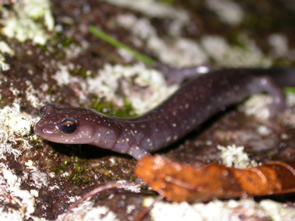
Wehrle's Salamander
Plethodon wehrlei
Plethodon wehrlei
Photo by J Mays
Listed: State Threatened.
Description: The Wehrle’s salamander has a dark brown to black base color with white, bluish-white, or yellowish blotches along the sides of the body. Hatchlings and small juveniles may have pairs of red spots on the back. Adults may lack conspicuous markings on the back or have paired yellow spots or white to brassy flecking. The underside of this salamander is uniformly grey except for the throat and upper chest which are blotched with white or yellow. The hind feet of this salamander have extensive webbing for a terrestrial salamander.
Habitat/Range: Wehrle’s salamanders are found only in a small area in northwestern North Carolina. They occur primarily in upland or forests with abundant rock ledges. They may be found in rock crevices, under rotting logs, or around cave entrances. These salamanders move underground in early summer and are difficult to find until the onset of cooler weather in early Fall.
Diet: Wehrle’s salamanders remain under cover during the day and emerge at night to forage for a wide variety of invertebrates.
Reproduction: Wehrle’s salamanders are thought to lay their eggs in underground retreats. The female remains to guard her eggs until they hatch. Wehrle’s salamander hatchlings do not go through an aquatic larval stage. Instead, when young salamanders emerge from their eggs they look like miniature adults.

The shaded region represents the range of Wehrle's salamander in North Carolina.

